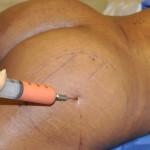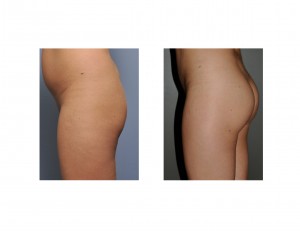
This combination of waist and hip change has long been regarded as attractive in many cultures around the world. A waist-hip ratio of 0.7 in females is the aesthetic ideal and may be achievable with a BBL surgical approach. The question is how effective is this procedure in reaching this aesthetic ideal and how successful is the fat that is injected maintained.
In the May 2015 issue of the journal Plastic and Reconstructive Surgery, the article entitled ‘Gluteoplasty with Autologous Fat Tissue: Experience with 106 Consecutive Cases’. In this paper the authors looked at 106 consecutive female patients who underwent a BBL procedure over a three year period. One key inclusion factor is that they could not have a weight change greater than 10% during the follow-up period. The degree of satisfaction (patient and surgeon) was assessed on a scale of 1 to 4 with four being the highest rating. The average age of the patients was 33 years old and the average amount of fat injected into the buttocks was 505ccs. No patients experienced any medical complications. Five patients (4%) developed a seroma in the liposuction harvest area. The vast majority of the patients (103 out of 106, 97%) has high satisfaction ratings of 3 and 4. Only one patient (1%) reported aesthetically troubling fat volume loss months after the procedure. Two patients (2%) had revision procedures for excessive gluteal fullness at the sides of the buttocks.
As can be seen in this study, BBL surgery has a high satisfaction rate with a very low incidence of any major problems. The autologous nature of the procedure is undoubtably the reason for few complications. Their experience shows that such fact injections are sustainable and not prone to a high rate of resorption after surgery. The one aesthetic problem that they did encounter infrequently was too much lateral fullness. This can be avoided by drawing a line laterally between the anterior and posterior hip area and not injecting in front of this line.

Fat grafting to the buttocks is known to have a lower rate of resorption than that which occurs in the face. The exact reason is not known but may be a function of a larger muscle mass and higher volumes of fat injected. As a result, BBL surgery usually has better results and higher patient satisfaction than facial fat grafting. The fat redistribution effect is also more likely to achieve a pronounced recontouring than just fat grafting alone.
It is important to point out that no patients in this study was injected with mega volumes of fat (1,000ccs or greater) nor ws there an attempt to balloon out the buttocks to very large proportions. The success in this study’s patients may not translate to high volume buttock fat injections.
Dr. Barry Eppley
Indianapolis, Indiana


